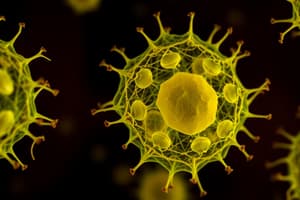Podcast
Questions and Answers
What is the unifying principle of the biological sciences?
What is the unifying principle of the biological sciences?
- Taxonomy
- Anatomy
- Biochemistry
- Evolution (correct)
Which of the following statements is not a risk associated with science and technology?
Which of the following statements is not a risk associated with science and technology?
- Science and technology are not risk-free.
- Science and technology can be value-neutral.
- Science and technology are always beneficial. (correct)
- Science and technology are wrong.
Which of the following is not a basic theory of biology?
Which of the following is not a basic theory of biology?
- Gene theory
- Theory of gravity (correct)
- Cell theory
- Theory of evolution
In a study where neither the patient nor the examiner knows whether a patient is receiving treatment, this study is classified as what?
In a study where neither the patient nor the examiner knows whether a patient is receiving treatment, this study is classified as what?
Which domain contains the kingdom(s) that include complex cellular structures?
Which domain contains the kingdom(s) that include complex cellular structures?
The face of a sunflower turning to follow the sun is an example of which biological concept?
The face of a sunflower turning to follow the sun is an example of which biological concept?
What term describes the information collected during an experiment?
What term describes the information collected during an experiment?
The region where populations interact with each other and the physical environment is called what?
The region where populations interact with each other and the physical environment is called what?
Which of the following sequences correctly orders biological organization from smallest to largest?
Which of the following sequences correctly orders biological organization from smallest to largest?
In a swamp, what do all the alligators represent?
In a swamp, what do all the alligators represent?
In an experiment testing the effect of temperature on goldfish respiration, what type of variable are the temperatures that are changed?
In an experiment testing the effect of temperature on goldfish respiration, what type of variable are the temperatures that are changed?
What appears to be the cause of stomach ulcers?
What appears to be the cause of stomach ulcers?
The term for all changes that occur from egg fertilization through adulthood is called what?
The term for all changes that occur from egg fertilization through adulthood is called what?
If a cell under the microscope is found to contain a nucleus, what domain does this organism belong to?
If a cell under the microscope is found to contain a nucleus, what domain does this organism belong to?
Which statement most correctly defines homeostasis?
Which statement most correctly defines homeostasis?
Which organisms are most closely related to humans?
Which organisms are most closely related to humans?
Which option does not represent a possible origin of cell organelles in eukaryotes?
Which option does not represent a possible origin of cell organelles in eukaryotes?
Which function is NOT associated with the cytoskeleton?
Which function is NOT associated with the cytoskeleton?
Which type of protein fiber is primarily responsible for cellular movement and is very thin?
Which type of protein fiber is primarily responsible for cellular movement and is very thin?
How large is a nuclear pore compared to a ribosome?
How large is a nuclear pore compared to a ribosome?
Why is glycolysis thought to have evolved early in the history of life?
Why is glycolysis thought to have evolved early in the history of life?
The plasma membrane is composed of how many layers of phospholipids?
The plasma membrane is composed of how many layers of phospholipids?
Which organelle is often compared to a post office due to its functions?
Which organelle is often compared to a post office due to its functions?
Which type of junction is primarily involved in providing structural support between cells?
Which type of junction is primarily involved in providing structural support between cells?
Flashcards are hidden until you start studying
Study Notes
Biological Hierarchy
- Levels of organization include: cells, tissues, organs, organ systems, and organisms.
- Correct sequence: cells, tissues, organs, organ systems, organism.
Population and Ecology
- In a swamp, alligators represent a population.
- A community includes interactions among multiple populations.
Experimental Variables
- In experiments, the factor that is altered (e.g., temperature in goldfish respiration) is called the experimental variable.
Causes of Stomach Ulcers
- Stomach ulcers are primarily caused by the bacterium Helicobacter pylori.
Development Stages
- The process from fertilization to adulthood, including childhood and adolescence, is termed development.
Organism Classification
- Cells containing a nucleus belong to the domain Eukarya.
Homeostasis Definition
- Homeostasis is the ability of cells and organisms to maintain a relatively constant internal environment.
Relatedness to Humans
- Closely related organisms to humans include meerkats based on evolutionary lineage.
Response to Stimuli
- The sunflower’s movement to follow the sun is an example of response to stimuli.
Science and Technology Perspectives
- Science and technology can be considered value-neutral, recognizing risks alongside benefits.
Data Collection in Experiments
- Information collected during experiments or observations is known as data.
Unifying Principle of Biology
- The unifying principle of biological sciences is evolution.
Theories in Biology
- The theory of gravity is not considered a basic theory of biology.
Study Designs
- A double-blind study is one where neither the patient nor the examiner knows whether the treatment is being administered.
Ecological Interaction Regions
- The region where populations interact with their environment is termed an ecosystem.
Kingdoms in Domain Eukarya
- The domain Eukarya contains four kingdoms.
Human Life Aspects
- Traditions, beliefs, and values are aspects of human life.
Origins of Cell Organelles
- Possible origins of cell organelles in eukaryotes include engulfing heterotrophic bacteria to form mitochondria, but groups of prokaryotic cells living together is not an accepted origin.
Functions of the Cytoskeleton
- The cytoskeleton maintains cell shape, anchors organelles, and facilitates cellular movement but does not process proteins.
Protein Fibers
- Actin filaments are thin protein fibers used for cellular movement.
Nuclear Pore Size
- Nuclear pores in the nuclear envelope are larger than a ribosome.
Glycolysis Evolution
- Glycolysis is believed to have evolved early in life because it does not require oxygen and is present in most cells.
Plasma Membrane Structure
- The plasma membrane contains two layers of phospholipids.
Organelle Functions
- An organelle likened to a post office is the Golgi apparatus, as it processes and distributes proteins and lipids within the cell.
Studying That Suits You
Use AI to generate personalized quizzes and flashcards to suit your learning preferences.




